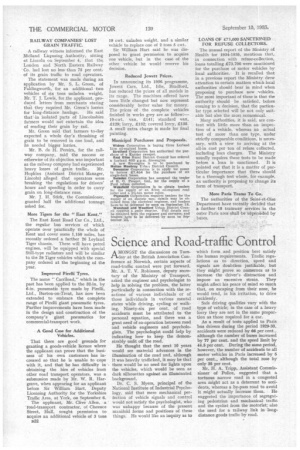Science and Road-traffic Control
Page 32

If you've noticed an error in this article please click here to report it so we can fix it.
AMONGST the discussions an Tuesday at the British Association Conference at Norwich, certain aspects of road-traffic control were put forward. Mr_ A. T. V. Robinson, deputy secretary of the Ministry of Transport, asked the engineer and psychologist to help in solving the problem, the latter particularly in connection with the reactions of various individuals or of those individuals in various mental states while driving, cycling or walking. Ninety-six per cent, of road accidents must be attributed to the personal equation, and there was a great need of co-operation between road and vehicle engineers and psychologists. The psychologist could help by indicating how to keep the demonstrably unfit off the road.
He thought that the next 10 years would see material advances in the illumination of the road and, although it was heavily trafficked, it may be that there would be no need for lights upon the vehicles, which would be seen as dark silhouettes against an illuminated background.
Dr. C. S. Myers, principal of the National Institute of Industrial Psychology, said that mere mechanical perfection of vehicle signals and control would not satisfy the psychologist, who was unhappy because of the present manifold forms and positions of these things. He would like an inquiry as to which form and position best satisfy the human requirements. Traffic regulations as to direction, speed and signals are doubtless justifiable, but they might prove so numerous as to increase the driver's distraction and impose an excessive strain. They might affect his peace of mind so much that, on escaping from their zone, he would tend, in his irritation, to drive recklessly.
Safe driving qualities vary with the type of vehicle; in the case of a heavy lorry they are not in the same proportion as those required for a car.
As a result of tests applied to Paris bus drivers during the period 1929-33, accidents were reduced by 66 per cent., although the number of buses increased by 77 per cent. and the speed limit by 44.5 per cent. During the same period, however, the number of accidents to all motor vehicles in Paris increased by 5 per cent., although the total rose by only 35 per cent.
Mr. H. A. Tripp, Assistant Commissioner of Police, suggested that a tortuous narrow road in a congested area might act as a deterrent to accidents, whereas a by-pass road to avoid it might actually increase them. He suggested the importance of segregating pedestrian and mechanical traffic and the cyclist from the motorist; also the need for a railway link in longdistance goods traffic by road.




















































































